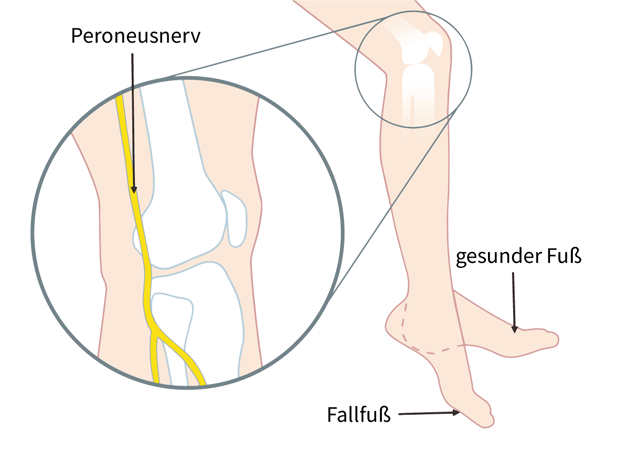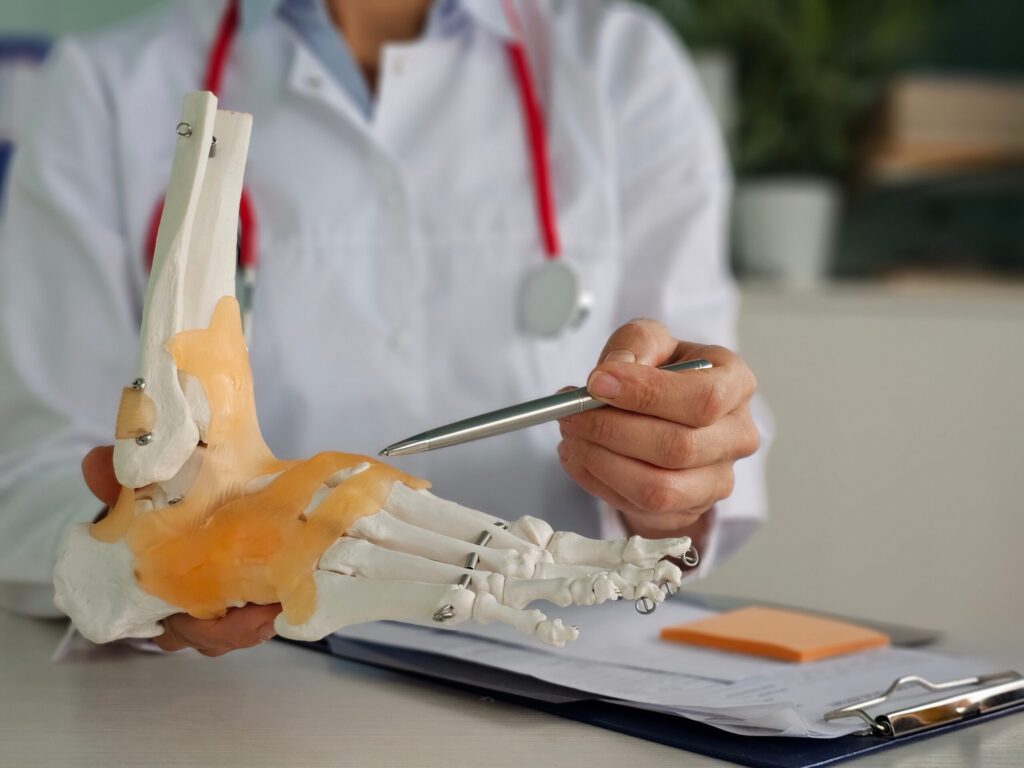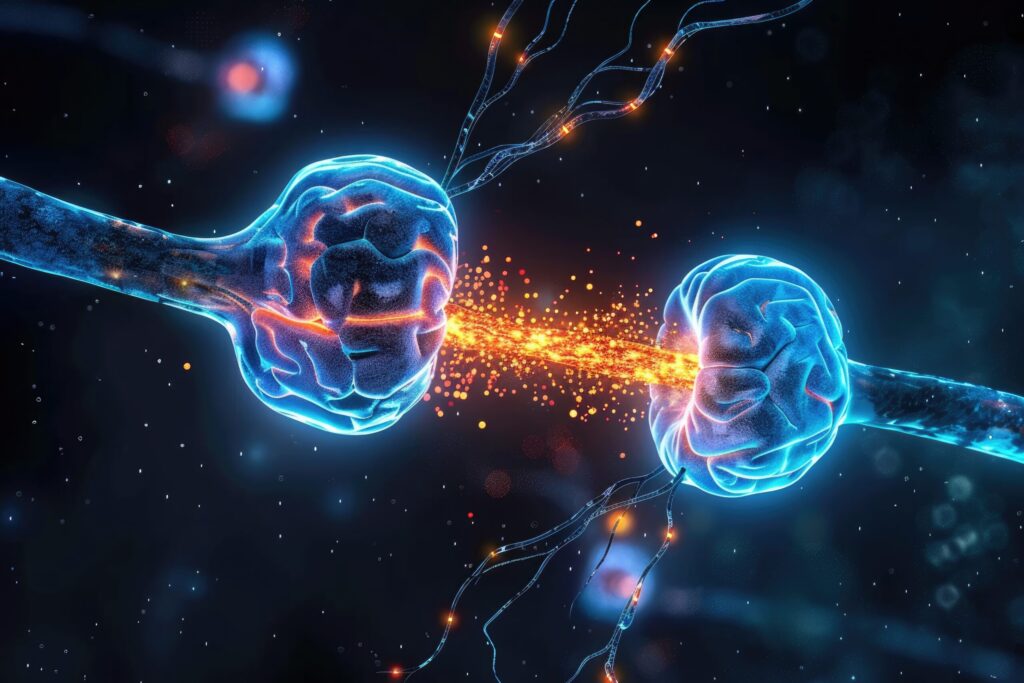Foot drop occurs when the strength of the muscles and nerves needed to lift the foot is lost. This weakness results from damage to the nerve and can occur in the brain, spinal cord or leg. In the case of foot drop (also known as peroneal palsy/peroneal nerve palsy), the brain can no longer correctly transmit the nerve impulses that control the lifting of the foot to the foot lifting muscles. The causes can vary: from a stroke, slipped disc or traumatic brain injury to unsuccessful hip surgery. Nerve diseases such as multiple sclerosis or Parkinson’s disease can also lead to peroneal nerve paralysis. In addition, the fibular nerve is susceptible to impact or crushing due to its course on the outside of the knee joint.

Foot drop manifests as a symptom due to nerve damage and describes the limited ability to lift the foot due to reduced strength in one or more of the following muscles:
The impairment of weak foot dorsiflexion is particularly noticeable during foot rolling and swinging the leg forward when walking. The forefoot, toes and/or lateral edge of the foot do not lift sufficiently or at all against the force of gravity(drop foot). This leads to a change in the gait pattern. The leg/knee must be lifted higher to prevent the affected person’s foot from sticking to the ground(stepping gait). Other adjustments to the gait pattern may also occur to prevent falls due to the foot catching. The persistent gait disorder leads to poor posture and pain over time. Early initiation of treatment is therefore recommended.

Walking on two legs is a natural but highly complex process: muscles/muscle groups in the foot, lower leg, thigh, hip and back have to interact with numerous joints as well as the senses of balance, sight and touch. In view of this, it quickly becomes clear how smoothly brain, nerve and muscle structures have to interlock here.
In peroneal nerve palsy, damage to brain or nerve cells means that the nerve can no longer receive signals or transmit them to the muscle as a motor command. As a result, patients with weak foot dorsiflexion are unable to lift (dorsiflexion) and roll the foot when walking. A common symptom is the drooping toe of the foot (plantar flexion), which drags on the ground.
To compensate for the lack of mobility in the leg, a so-called stepper gait can occur: Those affected swing the impaired leg forward with a gyroscopic hip movement (circumduction) and lift it in the process. This unnatural gait can lead to pain and strain in the hips and spine, and can even lead to a slipped disc. Another consequence of the cramped posture is that patients often walk on the outer edge of the foot or claw with their toes. Walking is therefore no longer a natural process, but requires a great deal of attention with every step, and the risk of tripping and falling is extremely high.
Foot drop palsy can have various causes, such as damage to brain and nerve cells caused by a stroke, slipped disc or trauma. However, nerve diseases such as multiple sclerosis or Parkinson’s disease can also lead to foot drop – the brain can no longer properly control the lifting of the foot.
Below you will find an overview of various complaints and clinical pictures that can lead to weak foot dorsiflexion:

Depending on the cause of the paresis, there are different therapies and approaches.
It is essential to seek immediate medical help and a diagnosis if paralysis suddenly occurs. This is because life-threatening factors such as a stroke could be the cause. In such situations, the underlying disease must be treated first, which usually leads to relief of the symptoms of paralysis, i.e. paresis. Acute foot drop can also be caused by a herniated disc. In this case, it is just as important to seek medical assistance immediately. In many cases, prompt treatment/surgery is recommended in order to avoid lasting damage to the nerve.
As foot drop usually occurs as a secondary injury, the medical focus is on treating the cause; the result can be an improvement in foot drop paresis. The innoSTEP-WL foot drop system has proven itself as an aid for improving mobility and quality of life: Via an electrode cuff on the leg, electrical impulses are sent to the peroneal nerve, which transmits them as a contraction command to the foot lifter muscle (tibialis anterior muscle) so that the foot lifts during the swing phase (dorsiflexion).
The innoSTEP-WL can enable patients with weak foot dorsiflexion to walk more naturally and safely without stumbling and falling, thereby reducing the consequential damage: The functional electrical stimulation promotes blood circulation and the sustained movement of the anterior tibial muscle counteracts muscle atrophy. At the same time, neuronal rewiring is supported, as information is constantly passed on to the brain and muscles and processed there. In the long term, an improvement in symptoms can be expected. Functional electrical stimulation (FES) can therefore be used very successfully as a form of therapy for weak foot dorsiflexion.
The innoSTEP-WL is an innovative, wireless foot drop system for functional electrical stimulation in cases of foot drop weakness and can help patients to improve their mobility and quality of life: Impulses are sent to the peroneal nerve (fibular nerve) via electrodes on the leg and transmitted to the shin muscle (tibialis anterior muscle) so that the foot lifts when walking. The foot lift system (also known as an electric orthosis or myoorthosis) therefore enables a more natural, safer gait pattern through electrical stimulation. In the long term, the repeated transmission and processing of stimuli by the central nervous system is expected to lead to neuronal rewiring. This leads to an improvement in gait and could therefore replace peroneal splints and orthoses.
The innoSTEP-WL foot support system can be prescribed by your attending physician. You can send medical prescriptions directly to HELLER MEDIZINTECHNIK GmbH & Co KG. After approval by your health insurance company, you will be instructed in its use by a trained medical device consultant. You can also purchase the device.
We will of course be happy to advise you on fitting the innoSTEP-WL and other aids from the field of electromedicine: simply give us a call (+49(0)6442 9421-0), send us an e-mail or use our contact form. Further information and materials – such as a sample prescription – can be found here.

incl. VAT
zzgl. Versandkosten
Select options This product has multiple variants. The options may be chosen on the product pageThe innoSTEP-WL is an aid for functional electrical stimulation for weak foot dorsiflexion, which can be prescribed by a doctor and covered by statutory health insurance. The necessary prescription can be issued by your family doctor or specialist. More and more doctors are giving you the option of requesting your prescription by phone or e-mail without having to visit the practice. Talk to your doctor. Depending on the patient’s insurance status, treatment is then provided in two different ways:
Legally insured persons
Privately insured persons
We will of course be happy to advise you on the supply of the innoSTEP-WL: simply call us on +49 (0)6442 9421-0, send us an e-mail or use our contact form. Further information and materials – such as a sample prescription – can be found here.
HELLER MEDIZINTECHNIK GmbH & Co. KG has been a certified medical technology company for over 25 years and has many years of experience in designing solutions in the field of electrical nerve and muscle stimulation.
2025 © HELLER MEDIZINTECHNIK GmbH & Co. KG